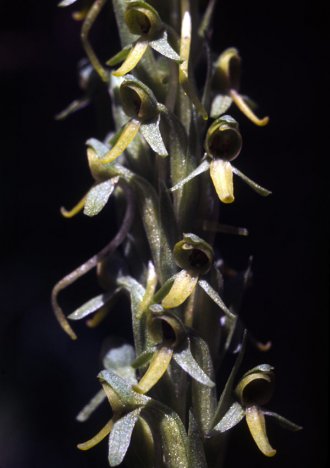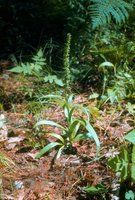Platanthera limosa
|
|
|
|
Family: Orchidaceae
Thurber's Bog Orchid
[Habenaria limosa (Lindl.) Hemsl., moreLimnorchis thurberi (A. Gray) Rydb., Platanthera vulcanica Lindl.] |
Plants 30-165 cm. Leaves few to several, spreading-ascending on base of stem, gradually reduced to bracts upwards; blade lanceolate, 9-28 × 1.2-3.5 cm. Spikes dense to lax. Flowers resupinate, inconspicuous, green; lateral sepals reflexed to spreading; petals lanceolate-, ovate-oblong-, or ovate-falcate, margins entire; lip descending to reflexed, linear-oblong, linear-elliptic, or rhombic-ovate, usually with inconspicuous to scarcely discernable (possibly sometimes absent) median basal thickening, 2.5-8.5 × less than 1-3.5 mm, margins entire; spur filiform, tapering toward apex, very rarely filiform-conic from slightly stout base, 8-25 mm; rostellum lobes mostly parallel, closely spaced, directed downward, very small, rounded, obscure; pollinaria straight; pollinia remaining enclosed in anther sacs; viscidia evidently elliptic-oblong; ovary rather slender to stout, mostly 4.5-11 mm. Flowering Jun--Aug. Open to lightly forested springy marshes, seeps, stream banks; 1800--2500 m (-- 4000 m, Central America); Ariz., N.Mex.; Mexico; Central America (to Guatemala). Platanthera limosa is traditionally distinguished from other slender-spurred plants and from P. sparsiflora by the presence on the lip of a median thickening that culminates in a small basal process. Although diagnostic when present, this feature is often obscure, especially in live material, and seems to be lacking in some plants. Platanthera limosa is most consistently separated from other green-flowered species by the combination of very small, narrow column and slender spur much longer than the lip. These features are in contrast to the very large, broad columns of P. sparsiflora and P. zothecina and much shorter spurs of the P. hyperborea complex. The lips of most plants are elliptic to elliptic-oblong, unlike any other species except the Aleutian P. tipuloides, and such plants are readily determined by lip shape and spur characters. Within populations plants may vary greatly in flower size, spur shape and length, and the ratio of spur to lip length. Individual plants may vary markedly in size of the flowers and density of the inflorescence in different years. That situation warrants additional study, as it may obscure the presence of other taxa.
FNA , Kearney and Peebles 1969, Martin and Hutchins 1980 Duration: Perennial Nativity: Native Lifeform: Forb/Herb General: Glabrous plant 30-165 cm, emerging from thickened, fleshy roots. Leaves: Mostly cauline, few to several, spreading ascending on base of stem, gradually reduced above, blade lanceolate 9-28 cm long by 1.2-3.5 cm wide. Flowers: Dense to lax spicate raceme with resupinate flowers, inconspicuous, whitish green with lateral sepals reflexed to spreading, petals lanceolate, ovate to oblong, with entire margins; lip descending to reflexed, linear-oblong to linear elliptic, with barely discernible median basal thickening; spur filiform, tapering toward apex, very rarely filiform-conic, from slightly stout base, 8-25 mm, mostly parallel rostellum lobes, directed downward, viscidia evidently elliptic oblong. Fruits: Slender capsule, 4.5-11 mm long. Ecology: Found in marshes, seeps, springs and other sites with wet soils from 7,000-9,000 ft (2134-2743 m); flowers June-September. Notes: Distinguished from P. sparsiflora by the the median thickening on the lip that ends up in a small basal appendage, but this is often an obscure characteristic. Alternatively, it can be distinguished from other species by the combination of very small, narrow column and a slender spur much longer than the lip. Ethnobotany: Unknown Etymology: Platanthera is from Greek for flat and flower, for the wide flat anther,while limosa means pertaining to marshy places. Synonyms: Habenaria limosa, Limnorchis thurberi Editor: SBuckley, 2010 |


